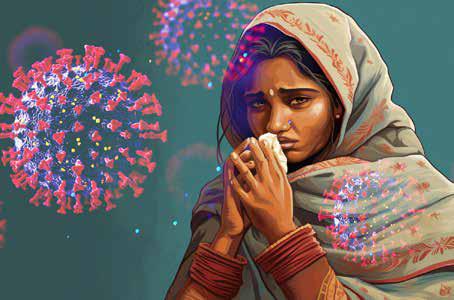Influenza – All Over the News Again

Acute respiratory illnesses are the most common problems of childhood and commonly they occur due to influenza viruses. Infection rates are higher in preschool children. It is generally considered as a mild disease; however, it may contribute to significant morbidity and mortality, especially in infants and children with underlying chronic medical conditions.
Something about the culprit
Influenza viruses are RNA viruses and are of three types- Type A, B and C. Type A influenza viruses are antigenically unstable, and known to undergo mutations (changes) within the viral genome (antigenic shift) causing sporadic cases, seasonal outbreaks and epidemics.
The peak of influenza cases is noted in the month of June to September, coinciding with the monsoon in India. Overcrowding helps in rapid transmission of infection, mostly affecting urban and suburban areas.
Disease transmission occurs through droplets from an infected person or through direct contact with the person or fomites. Incubation period of influenza is short, 1–2 days only. Peak viral shedding occurs on the first day of illness but the communicable period may last up to 7–10 days in young children
Clues to pick up
Common presentation is fever, chills, running nose, cough, sore throat, headache and bodyache. Diarrhea, vomiting and abdominal pain may be seen. In uncomplicated cases, the disease lasts for 3–4 days with resolution of disease in 7–10 days. The infants and young children may look very sick, toxic and present with illness resembling sepsis, pneumonia, croup or bronchiolitis.
When to worry ?
If a child has fast breathing or breathing difficulty, difficulty in feeding, decreased urination, one should bring the baby to hospital immediately.
Treatment
Treatment options primarily depend on the disease severity. Children with mild disease can be managed at home with supportive care including rest, adequate fluid intake, paracetamol for fever and body ache.
Children with risk factors or moderate to severe disease require hospitalization and are
managed with hydration, oxygenation, anti-pyretics, and antiviral drugs.
When to refer to Specialist/ Higher Centre
Most of the children can be managed at home or primary health center, however, children
with following conditions should be considered for early referral:
Children with high fever and sore throat interfering with feeding
Persistent vomiting
Dull, lethargic and drowsy child
Prevention
Currently, 2 types of vaccines are available for use with good efficacy, commonly known as “Flu Shots” - Live Attenuated Influenza Vaccine (LAIV) and Inactivated Influenza Vaccine (IIV). LAIV is used in kids above 2 years. In India, Inactivated Influenza Vaccine (IIV) is only available for use as of now.
Recommendation
First time vaccination 6 months to 8 years: 2 doses 4 weeks apart
9 years and above - single dose.
Annual re-vaccination with single dose. Most recent strains-containing vaccines, before the
monsoon period starts. It takes about two weeks after vaccination to develop protective
levels of antibodies against influenza.



